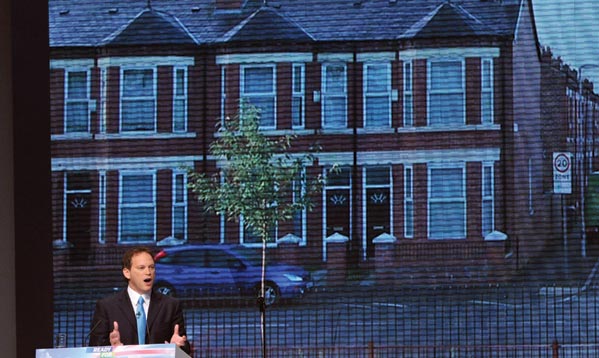By Claudia Wood | 1 June 2012
Rows about ‘exporting’ Housing Benefit claimants have hit the headlines. But the underlying problem is a severe shortage of affordable housing
 When the cap on Housing Benefit was first announced, phrases like ‘Kosovo-style social cleansing’ hit the headlines. It was predicted that in London, where 80% of those affected by the cap live, the consequences would be dire. There then followed a period of quiet. Even though the cap was introduced over a year ago, it is only in the past few weeks that people’s attention has been drawn back to the implications for the capital’s households.
When the cap on Housing Benefit was first announced, phrases like ‘Kosovo-style social cleansing’ hit the headlines. It was predicted that in London, where 80% of those affected by the cap live, the consequences would be dire. There then followed a period of quiet. Even though the cap was introduced over a year ago, it is only in the past few weeks that people’s attention has been drawn back to the implications for the capital’s households.
It emerged in April that the London Borough of Newham had written to Stoke-on-Trent City Council, where rental prices fall inside the government’s cap, asking whether it could lease some homes for people on Newham’s housing waiting list.
This seems a radical step, particularly as Stoke is far away in Staffordshire. The idea that housing caps will lead to people who have lived in their homes for many years, close to friends and with children in local schools, having to move hundreds of miles away is a disturbing one.
But the detail behind the headlines is more complex. Newham actually sent out 1,000 letters to organisations enquiring about housing. No doubt this included boroughs closer to home than the Midlands. Other London authorities that have needed to find out-of-borough homes due to the housing cap have sent families to Luton, Hertfordshire and Kent. And this isn’t unusual. Recently, BBC London found that 65% of London boroughs had housed families outside their borough, while 38% had sent families out of London.
Also, the idea that people would be uprooted from the homes they have lived in for years due to the cap is an overstatement. The English housing survey 2010/11 from the Department for Communities and Local Government found that only 11% of private renters had lived in their homes for more than 10 years and 36% had had a tenancy for less than 12 months. The average tenure of private housing is one year, compared with 11 years for owner-occupiers and seven for social housing residents.
The impact of moving is far greater for home owners facing repossession – which is now more common following the government’s cut to Support for Mortgage Interest payments by up to £200 per month. Yet there was less furore about this cut – potentially affecting 250,000 people, more than ten times the number predicted to be affected by the rental cap.
We should also remember that in Newham at least, the families that could be moved to other boroughs are those on the waiting list – perhaps living in B&Bs at the moment – rather than those settled in a rented home of long standing. Westminster, another London council looking to move families out of its area, has said it is selecting people based on those with the fewest links to the borough – those without jobs, families or children attending schools in Westminster. Those well settled are to be offered top-up payments so that any shortfall in benefit won’t mean they have to move out of their homes.
But even with these measures aimed at alleviating the impact of the reform, the argument remains: should benefit claimants be forced to move elsewhere if the state withdraws its support?
The government believes it is unfair that benefits claimants should be supported by the state to rent properties in areas of London that are beyond the budgets of the vast majority of working people. Most private renters in London have to make a trade-off between the length of their commute, the shabbiness of their local shops and their budget. And if one loses a flatmate, changes jobs or, in this economic climate, is made redundant, then a move to a cheaper property, perhaps further out of town, is inevitable.
Millions of people in London and across the country who are familiar with this situation might not see why Housing Benefit recipients should be insulated from such moves.
But most central London renters would baulk at the prospect of moving out to Essex, let alone the Midlands. The Stoke plan resembles the war-time evacuation of London or, less charitably, the export of homelessness. The burden this would place on the GPs, schools, and other services in Stoke and other recipient areas is yet to be fully explored.
But whichever side one comes down on regarding the ‘right’ or the ‘privilege’ of people to live in highly priced London boroughs is missing the point. Because we are debating a solution to the wrong problem.
Housing minister Grant Shapps accused Labour-led Newham of playing politics by going public with such a radical solution to its shortage of affordable housing a few weeks before the May local and mayoral elections. He rightly pointed out that there were 1,000 affordable rented properties within five miles of Newham. But he failed to acknowledge the widespread problem in the private rental market – many private landlords will not let to Housing Benefit recipients.
Reasons cited for this include Housing Benefit being paid one month in arrears, the complex administration leading to unexpected stops and starts in benefit payments and the frequent lack of a deposit. So only a part of the affordable renting market might be available to Housing Benefit recipients. And even if all of these 1,000 affordable rentals were up for grabs, this figure is dwarfed by the 32,000 people on Newham’s housing waiting list.
In this debate, the elephant in the room is the massive under-supply of affordable homes. Is the government paying people too much Housing Benefit to live in otherwise unaffordable properties? Probably yes.
But is the solution simply to reduce the payments? Or rather, should it be to build a larger number of affordable properties to remove the need for such high payments? The answer seems obvious, but in 2009 the number of new houses being built fell to its lowest level since 1923.
About 250,000 homes will need to be built in England every year to keep up with demand – yet according to the DCLG’s Net supply of housing survey, 2010/11, only 121,200 dwellings were added to the stock. This is a 6% decrease on the previous year, after a 23% drop between 2008/09 and 2009/10. And where in England was this decline the greatest? In London, which had a 27% decrease.
This shortage, leading to spiralling increases in rents and Housing Benefit costs, has provoked the government’s short-term measure of capping demand. The only sustainable solution to the Housing Benefit problem is to increase supply throughout the social housing sector, where most claimants already live in more stable circumstances. The Housing Benefit cap is a demand-side solution to a supply-side problem. Fixing it should be a job for Shapps, not for Work & Pensions Secretary Iain Duncan Smith and his welfare reforms.
Claudia Wood is deputy director at Demos
This article first appeared in the June issue of Public Finance


Rows about ‘exporting’ Housing Benefit claimants have hit the headlines. But the underlying problem is a severe shortage of affordable housing
 When the cap on Housing Benefit was first announced, phrases like ‘Kosovo-style social cleansing’ hit the headlines. It was predicted that in London, where 80% of those affected by the cap live, the consequences would be dire. There then followed a period of quiet. Even though the cap was introduced over a year ago, it is only in the past few weeks that people’s attention has been drawn back to the implications for the capital’s households.
When the cap on Housing Benefit was first announced, phrases like ‘Kosovo-style social cleansing’ hit the headlines. It was predicted that in London, where 80% of those affected by the cap live, the consequences would be dire. There then followed a period of quiet. Even though the cap was introduced over a year ago, it is only in the past few weeks that people’s attention has been drawn back to the implications for the capital’s households. It emerged in April that the London Borough of Newham had written to Stoke-on-Trent City Council, where rental prices fall inside the government’s cap, asking whether it could lease some homes for people on Newham’s housing waiting list.
This seems a radical step, particularly as Stoke is far away in Staffordshire. The idea that housing caps will lead to people who have lived in their homes for many years, close to friends and with children in local schools, having to move hundreds of miles away is a disturbing one.
But the detail behind the headlines is more complex. Newham actually sent out 1,000 letters to organisations enquiring about housing. No doubt this included boroughs closer to home than the Midlands. Other London authorities that have needed to find out-of-borough homes due to the housing cap have sent families to Luton, Hertfordshire and Kent. And this isn’t unusual. Recently, BBC London found that 65% of London boroughs had housed families outside their borough, while 38% had sent families out of London.
Also, the idea that people would be uprooted from the homes they have lived in for years due to the cap is an overstatement. The English housing survey 2010/11 from the Department for Communities and Local Government found that only 11% of private renters had lived in their homes for more than 10 years and 36% had had a tenancy for less than 12 months. The average tenure of private housing is one year, compared with 11 years for owner-occupiers and seven for social housing residents.
The impact of moving is far greater for home owners facing repossession – which is now more common following the government’s cut to Support for Mortgage Interest payments by up to £200 per month. Yet there was less furore about this cut – potentially affecting 250,000 people, more than ten times the number predicted to be affected by the rental cap.
We should also remember that in Newham at least, the families that could be moved to other boroughs are those on the waiting list – perhaps living in B&Bs at the moment – rather than those settled in a rented home of long standing. Westminster, another London council looking to move families out of its area, has said it is selecting people based on those with the fewest links to the borough – those without jobs, families or children attending schools in Westminster. Those well settled are to be offered top-up payments so that any shortfall in benefit won’t mean they have to move out of their homes.
But even with these measures aimed at alleviating the impact of the reform, the argument remains: should benefit claimants be forced to move elsewhere if the state withdraws its support?
The government believes it is unfair that benefits claimants should be supported by the state to rent properties in areas of London that are beyond the budgets of the vast majority of working people. Most private renters in London have to make a trade-off between the length of their commute, the shabbiness of their local shops and their budget. And if one loses a flatmate, changes jobs or, in this economic climate, is made redundant, then a move to a cheaper property, perhaps further out of town, is inevitable.
Millions of people in London and across the country who are familiar with this situation might not see why Housing Benefit recipients should be insulated from such moves.
But most central London renters would baulk at the prospect of moving out to Essex, let alone the Midlands. The Stoke plan resembles the war-time evacuation of London or, less charitably, the export of homelessness. The burden this would place on the GPs, schools, and other services in Stoke and other recipient areas is yet to be fully explored.
But whichever side one comes down on regarding the ‘right’ or the ‘privilege’ of people to live in highly priced London boroughs is missing the point. Because we are debating a solution to the wrong problem.
Housing minister Grant Shapps accused Labour-led Newham of playing politics by going public with such a radical solution to its shortage of affordable housing a few weeks before the May local and mayoral elections. He rightly pointed out that there were 1,000 affordable rented properties within five miles of Newham. But he failed to acknowledge the widespread problem in the private rental market – many private landlords will not let to Housing Benefit recipients.
Reasons cited for this include Housing Benefit being paid one month in arrears, the complex administration leading to unexpected stops and starts in benefit payments and the frequent lack of a deposit. So only a part of the affordable renting market might be available to Housing Benefit recipients. And even if all of these 1,000 affordable rentals were up for grabs, this figure is dwarfed by the 32,000 people on Newham’s housing waiting list.
In this debate, the elephant in the room is the massive under-supply of affordable homes. Is the government paying people too much Housing Benefit to live in otherwise unaffordable properties? Probably yes.
But is the solution simply to reduce the payments? Or rather, should it be to build a larger number of affordable properties to remove the need for such high payments? The answer seems obvious, but in 2009 the number of new houses being built fell to its lowest level since 1923.
About 250,000 homes will need to be built in England every year to keep up with demand – yet according to the DCLG’s Net supply of housing survey, 2010/11, only 121,200 dwellings were added to the stock. This is a 6% decrease on the previous year, after a 23% drop between 2008/09 and 2009/10. And where in England was this decline the greatest? In London, which had a 27% decrease.
This shortage, leading to spiralling increases in rents and Housing Benefit costs, has provoked the government’s short-term measure of capping demand. The only sustainable solution to the Housing Benefit problem is to increase supply throughout the social housing sector, where most claimants already live in more stable circumstances. The Housing Benefit cap is a demand-side solution to a supply-side problem. Fixing it should be a job for Shapps, not for Work & Pensions Secretary Iain Duncan Smith and his welfare reforms.
Claudia Wood is deputy director at Demos
This article first appeared in the June issue of Public Finance



















